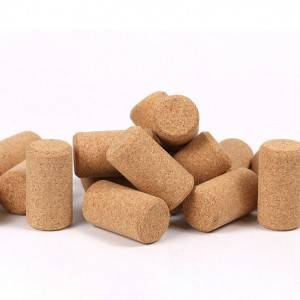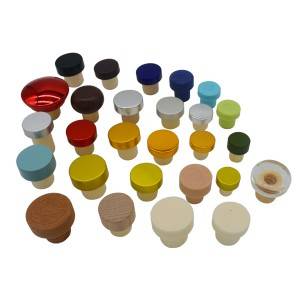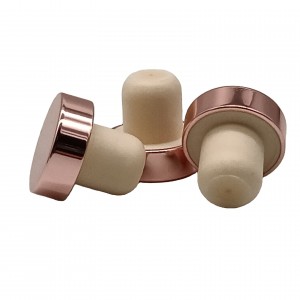-

Nature cork design logo free samples high quality corks
Generally, we all know that the stopper of wine is called cork, although occasionally there are red wines with screw cap, rubber stopper, glass stopper and other stoppers, but it does not prevent the dominance of cork.
But is cork made of oak? The answer is not that oak is hard and not suitable for corks, but it is a great material for making oak barrels. And what we usually call cork is made from the bark of the cork oak.
This type of oak skin produces corks of the right tightness and best quality. Cork sealing the bottle is not to make the whole bottle airtight, wine is a living wine, need to breathe, if airtight, the wine is impossible to mature, into a bottle of dead wine. So the cork has a tremendous effect on the quality of the wine.
In order to ensure the quality of the cork, softwood TREES ARE HARVESTED EVERY nine years. The bark of cork trees can regenerate, but summers in the Mediterranean are so hot that workers often leave part of the bark behind to protect the cork trees.
In general, it is best to place the bark on concrete after harvesting and allow it to air dry, while also avoiding contamination. After that, the cork is selected and the boards that are completely unusable are removed. Compared to the image on the right, the cork on the left is too thin to make high-quality natural corks, but it can still be used to make technical stoppers.
After the cork is made, the machine will automatically send it to the corresponding grade container. Then, the worker will screen and sort the cork again to ensure its quality. Therefore, the best corks are left after screening, and the price is certainly not cheap. The cork will be made according to the requirements of different customers, in the cork above the engraved with different alphabet patterns, and finally become the oak cork we usually use.
-

Nature cork high quality free samples corks for wine vodka whisky glass bottle
Known as the patron saint of wine, corks have long been considered ideal wine stoppers because they are flexible and seal the bottle well without completely trapping air, allowing the wine to develop and mature slowly. Do you know how corks are actually made?
Cork (https://www.ythongning.com/nature-cork-2-product/)is made from the bark of cork oak. Cork oak is a deciduous tree of the quercus family. It is a slow-growing, evergreen oak found in some parts of the western Mediterranean. Cork oak has two layers of bark, the inner bark has vitality, and the outer bark can be removed without affecting the survival of the tree. Cork oak outer bark can provide a soft protective layer for trees, it is also a natural insulating layer, can protect trees from fire; The inner bark is the basis for the new outer bark that is born each year. Oak cork age reaches 25 years, can carry out the first harvest. But the first harvest of oak bark is too irregular in density and size to be used as a cork for wine bottles, and is usually used as a floor or good insulation. Nine years later, the second harvest can be made. But the harvest was still not of the quality required to make corks, and could only be used for accessory products such as shoes, accessories and household items. By the third harvest, the cork oak is more than forty years old, and the bark from this harvest is ready to be used to make corks. Thereafter, every 9 years cork oak will naturally form a layer of bark. Typically, the cork oak has a life span of 170-200 years and can produce 13-18 useful harvests during its lifetime.
After the cork is made, it needs to be washed. Some customers have requirements on color, so some bleaching will be carried out during the washing process. After washing, workers will screen the finished corks and pick out the products with surface defects such as fine edges or cracks. High quality corks have a smooth surface and few fine pores. Finally, the manufacturer will be based on the requirements of the customer on the cork printing, do the final treatment. Printed information includes the origin of the wine, the region, the name of the winery, the year the grapes were picked, bottling information or the year the winery was founded. However, some cork manufacturers ship the finished product to branches in different countries to be printed by specific customers. Mimeograph or fire printing technology is usually used in the printing of jet characters. Mimeographing is cheaper and the ink will seep into the stopper and come off easily. Fire printing technology costs more, but the printing quality is good. Once the printing is done, the cork is ready to seal the bottle.
-

Wine Bottle Wooden Cork T shape Customized logo corks high quality
The Cork, or corkoak, is a soft, elastic wood with many holes in it that make it softer when soaked in water. Seventy percent of the cork is made into a wine stopper. This kind of wood is made after cutting the cork(https://www.ythongning.com/nature-cork-2-product/), again through the machine will the stopper compaction and into the bottle, and advantage of the characteristics of the elastic expansion to return to original state, thus tightly sealed the bottleneck, so as to protect the wine in the bottle does not damage of leakage. The cork has many tiny holes in the inside, which allow the wine inside to breathe and develop (very little air enters, and the wine ripeness is through the gap between the cork and the bottle, not through the inside of the cork), thus making the wine the best.
How do so many corks continue to be produced?
Cork grows in countries with Mediterranean climates, such as Spain, Portugal, Morocco, Italy, Tunisia, France, etc. It doesn’t need irrigation, it doesn’t need pruning, it doesn’t need extra fertilizer. Portugal is the largest cork producer, and cork harvesting is regulated by the government. You can’t harvest it until it’s 25 years old, but when you first harvest it’s not very good, so you can only use it to make soles and stuff, not stoppers. When the tree is 42 years old, it can be harvested as a stopper, harvested every nine years and still alive for another 170 years or more. The harvest is done by skilled workers with good wages who use small axes to slowly chip away at the bark of the tree, which does little damage to the tree.
Eventually corks began to be graded according to quality, generally based on the number of holes. White corks are usually highly valued, although some vintners prefer a darker or natural color. Women usually use a quick thinking eye to pick out the best and most attractive of the seven levels of cork. In recent years, more than three classification standards have been added, in which the vast majority of manufacturing processes are done by machines. The human eye is the key to quality, and it is this grade of cork that ends up in the container for bottling.
-

synthetic Cork high quality corks for wine whisky vodka glass bottle
Polymer stopper is a stopper made of polyethylene foam. According to the production process, it can be divided into many kinds: joint extrusion stopper, separate extrusion stopper, molded foam stopper, and so on.
To taste a bottle of red wine, the natural thing to do is to uncork it.
When it comes to corks, most people have an image of sealing and protecting wine.But there are many different kinds of wine, so to “protect” these different qualities of wine, also need different materials, different kinds of stoppers.
After being made, some wines are aged in oak barrels for a period of time, and the rest of their lives are spent in the bottle until they are opened.How a wine is presented in terms of aroma and taste is largely related to the choice of cork. Today red wine network for you to introduce eight common red wine stopper - polymer bottle stopper.
Polymer bottle stopper is a bottle stopper made of polyethylene foam.It currently accounts for 22% of the bottled wine market.The advantage of polymer stoppers is that they eliminate cork flavor and breakage problems, and their product consistency is quite high, which can ensure that the whole batch of wine is in a roughly the same aging stage.At the same time, the technology of producing polymer stoppers continues to develop.
Through the control of oxygen permeability, the stoppers with different oxygen permeability rates can be produced to meet the needs of different wine varieties, so that winemakers can have the opportunity to understand and control the aging of bottles during storage.
-

Natural Cork
Polymer stopper is a stopper made of polyethylene foam. According to the production process, it can be divided into many kinds: joint extrusion stopper, separate extrusion stopper, molded foam stopper, and so on.
To taste a bottle of red wine, the natural thing to do is to uncork it.
When it comes to corks, most people have an image of sealing and protecting wine.But there are many different kinds of wine, so to “protect” these different qualities of wine, also need different materials, different kinds of stoppers.
After being made, some wines are aged in oak barrels for a period of time, and the rest of their lives are spent in the bottle until they are opened.How a wine is presented in terms of aroma and taste is largely related to the choice of cork. Today red wine network for you to introduce eight common red wine stopper - polymer bottle stopper.
Polymer bottle stopper is a bottle stopper made of polyethylene foam.It currently accounts for 22% of the bottled wine market.The advantage of polymer stoppers is that they eliminate cork flavor and breakage problems, and their product consistency is quite high, which can ensure that the whole batch of wine is in a roughly the same aging stage.At the same time, the technology of producing polymer stoppers continues to develop.
Through the control of oxygen permeability, the stoppers with different oxygen permeability rates can be produced to meet the needs of different wine varieties, so that winemakers can have the opportunity to understand and control the aging of bottles during storage.
-

High Quality Corks Customized Logo Factory Price For Wine Whisky Vodka Rum Glass Bottle
The Cork, or cork, is a soft, elastic wood with many holes in it that make it softer when soaked in water. Seventy percent of the cork is made into a wine stopper. This kind of wood is made after cutting the cork(https://www.ythongning.com/nature-cork-2-product/), again through the machine will the stopper compaction and into the bottle, and advantage of the characteristics of the elastic expansion to return to original state, thus tightly sealed the bottleneck, so as to protect the wine in the bottle does not damage of leakage. The cork has many tiny holes in the inside, which allow the wine inside to breathe and develop (very little air enters, and the wine ripeness is through the gap between the cork and the bottle, not through the inside of the cork), thus making the wine the best.
How do so many corks continue to be produced?
Cork grows in countries with Mediterranean climates, such as Spain, Portugal, Morocco, Italy, Tunisia, France, etc. It doesn’t need irrigation, it doesn’t need pruning, it doesn’t need extra fertilizer. Portugal is the largest cork producer, and cork harvesting is regulated by the government. You can’t harvest it until it’s 25 years old, but when you first harvest it’s not very good, so you can only use it to make soles and stuff, not stoppers. When the tree is 42 years old, it can be harvested as a stopper, harvested every nine years and still alive for another 170 years or more. The harvest is done by skilled workers with good wages who use small axes to slowly chip away at the bark of the tree, which does little damage to the tree.
Eventually corks began to be graded according to quality, generally based on the number of holes. White corks are usually highly valued, although some vintners prefer a darker or natural color. Women usually use a quick thinking eye to pick out the best and most attractive of the seven levels of cork. In recent years, more than three classification standards have been added, in which the vast majority of manufacturing processes are done by machines. The human eye is the key to quality, and it is this grade of cork that ends up in the container for bottling.





